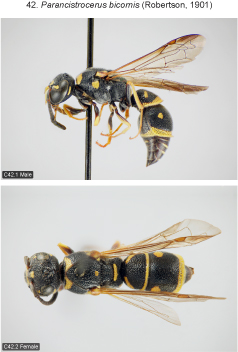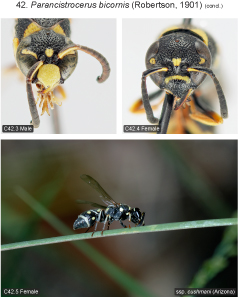
| Home | Table of contents | Keys | Species list | Glossary | Image data | PDF | Cite this article | Feedback | Updates |
Identification Atlas of the Vespidae (Hymenoptera, Aculeata) of the northeastern Nearctic region
CJAI 05, February 19, 2008
doi: 10.3752/cjai.2008.05
Matthias Buck, Stephen A. Marshall, and David K.B. Cheung
Department of Environmental Biology, University of Guelph, Guelph, Ontario, Canada N1G 2W1
Next species | Previous species | Key
42. Parancistrocerus bicornis (Robertson, 1901)
Figs B7.7, 48; C42.1–5.

|

|
Species recognition. This is the only species of the genus in the area covered by the key with an eye-lid like swelling behind the mid ocellus. The character is shared by several species of Stenodynerus (including S. blepharus which occurs in Ontario). From these species P. bicornis is distinguished by the strongly developed and medially uninterrupted pronotal carina, and the scattered long hairs on the summit and dorsal surface of tergum 1 (the only other species with long hairs are P. salcularis and P. leionotus). Further diagnostic characters include: interocellar tubercles between hind ocelli well-developed, especially in male; weak, impunctate, ocular swellings at summit of eyes just behind level of hind ocelli (as in Stenodynerus pulvinatus and often P. salcularis); male flagellum yellowish to obscure reddish beneath (especially basal segments); pronotum with relatively large, smooth interspaces, appearing more polished than in most other species; scutum with yellow posteromedial spot (often absent in male); male mid femur without anteroventral depression near base; terga 1 and 2 with discal spots (often absent on tergum 2 or both terga in male); summit of tergum 1 with an irregular transverse carina formed by enlarged confluent punctures followed by smooth area; hind margin of tergum 2 distinctly thickened (often very strongly in male).
Variation. Fore wing length 5.5–7.0 mm (♂♂), 6.5–7.5 mm (♀♀). Variation otherwise not studied.
Distribution. Not recorded from Canada. Eastern U.S.: MI and NY south to FL and AR, west to AZ (Krombein 1979). The bright yellow-marked form that occurs across most of the range of the species is ssp. ceanothi (Rohwer, 1912). The nominate subspecies from Florida has reddish markings; ssp. cushmani (Bohart, 1949) from western TX to AZ has pale yellow markings (Fig. 42.5).
Biology. Subspecies cushmani nests in borings in wood and uses mud for nest partitions and closing plugs. The prey has not been recorded (Krombein 1967, 1979).
Next species | Previous species | Key
| Home | Table of contents | Keys | Species list | Glossary | Image data | PDF | Cite this article | Feedback | Updates |
